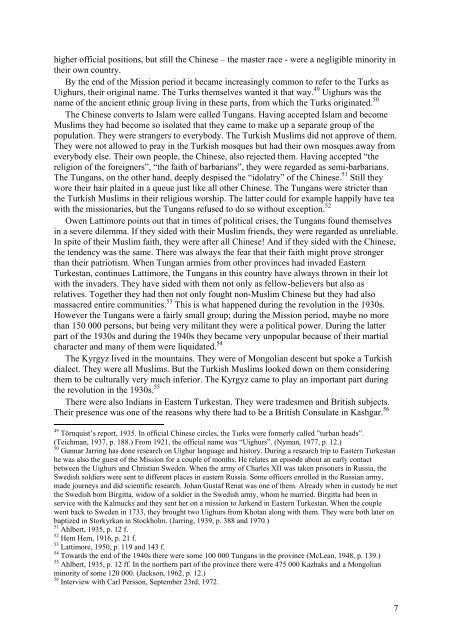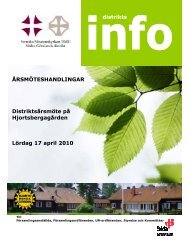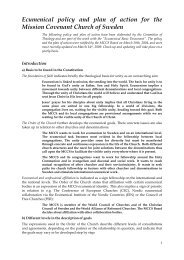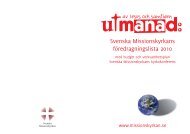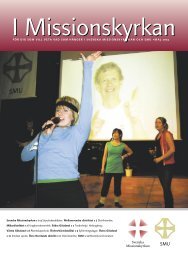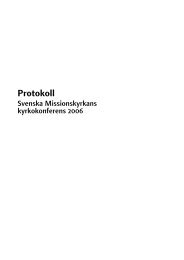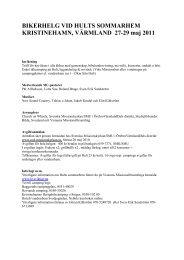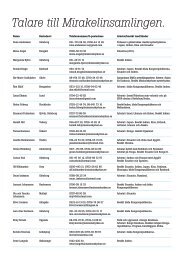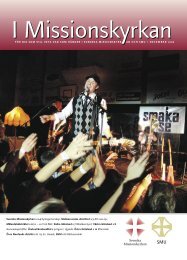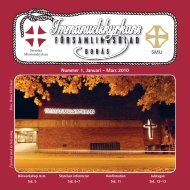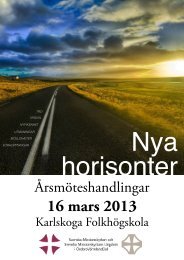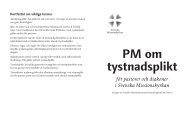Mission and Revolution in Central Asia - Svenska Missionskyrkan
Mission and Revolution in Central Asia - Svenska Missionskyrkan
Mission and Revolution in Central Asia - Svenska Missionskyrkan
Create successful ePaper yourself
Turn your PDF publications into a flip-book with our unique Google optimized e-Paper software.
higher official positions, but still the Ch<strong>in</strong>ese – the master race - were a negligible m<strong>in</strong>ority <strong>in</strong><br />
their own country.<br />
By the end of the <strong>Mission</strong> period it became <strong>in</strong>creas<strong>in</strong>gly common to refer to the Turks as<br />
Uighurs, their orig<strong>in</strong>al name. The Turks themselves wanted it that way. 49 Uighurs was the<br />
name of the ancient ethnic group liv<strong>in</strong>g <strong>in</strong> these parts, from which the Turks orig<strong>in</strong>ated. 50<br />
The Ch<strong>in</strong>ese converts to Islam were called Tungans. Hav<strong>in</strong>g accepted Islam <strong>and</strong> become<br />
Muslims they had become so isolated that they came to make up a separate group of the<br />
population. They were strangers to everybody. The Turkish Muslims did not approve of them.<br />
They were not allowed to pray <strong>in</strong> the Turkish mosques but had their own mosques away from<br />
everybody else. Their own people, the Ch<strong>in</strong>ese, also rejected them. Hav<strong>in</strong>g accepted “the<br />
religion of the foreigners”, “the faith of barbarians”, they were regarded as semi-barbarians.<br />
The Tungans, on the other h<strong>and</strong>, deeply despised the “idolatry” of the Ch<strong>in</strong>ese. 51 Still they<br />
wore their hair plaited <strong>in</strong> a queue just like all other Ch<strong>in</strong>ese. The Tungans were stricter than<br />
the Turkish Muslims <strong>in</strong> their religious worship. The latter could for example happily have tea<br />
with the missionaries, but the Tungans refused to do so without exception. 52<br />
Owen Lattimore po<strong>in</strong>ts out that <strong>in</strong> times of political crises, the Tungans found themselves<br />
<strong>in</strong> a severe dilemma. If they sided with their Muslim friends, they were regarded as unreliable.<br />
In spite of their Muslim faith, they were after all Ch<strong>in</strong>ese! And if they sided with the Ch<strong>in</strong>ese,<br />
the tendency was the same. There was always the fear that their faith might prove stronger<br />
than their patriotism. When Tungan armies from other prov<strong>in</strong>ces had <strong>in</strong>vaded Eastern<br />
Turkestan, cont<strong>in</strong>ues Lattimore, the Tungans <strong>in</strong> this country have always thrown <strong>in</strong> their lot<br />
with the <strong>in</strong>vaders. They have sided with them not only as fellow-believers but also as<br />
relatives. Together they had then not only fought non-Muslim Ch<strong>in</strong>ese but they had also<br />
massacred entire communities. 53 This is what happened dur<strong>in</strong>g the revolution <strong>in</strong> the 1930s.<br />
However the Tungans were a fairly small group; dur<strong>in</strong>g the <strong>Mission</strong> period, maybe no more<br />
than 150 000 persons, but be<strong>in</strong>g very militant they were a political power. Dur<strong>in</strong>g the latter<br />
part of the 1930s <strong>and</strong> dur<strong>in</strong>g the 1940s they became very unpopular because of their martial<br />
character <strong>and</strong> many of them were liquidated. 54<br />
The Kyrgyz lived <strong>in</strong> the mounta<strong>in</strong>s. They were of Mongolian descent but spoke a Turkish<br />
dialect. They were all Muslims. But the Turkish Muslims looked down on them consider<strong>in</strong>g<br />
them to be culturally very much <strong>in</strong>ferior. The Kyrgyz came to play an important part dur<strong>in</strong>g<br />
the revolution <strong>in</strong> the 1930s. 55<br />
There were also Indians <strong>in</strong> Eastern Turkestan. They were tradesmen <strong>and</strong> British subjects.<br />
Their presence was one of the reasons why there had to be a British Consulate <strong>in</strong> Kashgar. 56<br />
49<br />
Törnquist’s report, 1935. In official Ch<strong>in</strong>ese circles, the Turks were formerly called ”turban heads”.<br />
(Teichman, 1937, p. 188.) From 1921, the official name was “Uighurs”. (Nyman, 1977, p. 12.)<br />
50<br />
Gunnar Jarr<strong>in</strong>g has done research on Uighur language <strong>and</strong> history. Dur<strong>in</strong>g a research trip to Eastern Turkestan<br />
he was also the guest of the <strong>Mission</strong> for a couple of months. He relates an episode about an early contact<br />
between the Uighurs <strong>and</strong> Christian Sweden. When the army of Charles XII was taken prisoners <strong>in</strong> Russia, the<br />
Swedish soldiers were sent to different places <strong>in</strong> eastern Russia. Some officers enrolled <strong>in</strong> the Russian army,<br />
made journeys <strong>and</strong> did scientific research. Johan Gustaf Renat was one of them. Already when <strong>in</strong> custody he met<br />
the Swedish born Birgitta, widow of a soldier <strong>in</strong> the Swedish army, whom he married. Birgitta had been <strong>in</strong><br />
service with the Kalmucks <strong>and</strong> they sent her on a mission to Jarkend <strong>in</strong> Eastern Turkestan. When the couple<br />
went back to Sweden <strong>in</strong> 1733, they brought two Uighurs from Khotan along with them. They were both later on<br />
baptized <strong>in</strong> Storkyrkan <strong>in</strong> Stockholm. (Jarr<strong>in</strong>g, 1939, p. 388 <strong>and</strong> 1970.)<br />
51<br />
Ahlbert, 1935, p. 12 f.<br />
52<br />
Hem Hem, 1916, p. 21 f.<br />
53<br />
Lattimore, 1950, p. 119 <strong>and</strong> 143 f.<br />
54<br />
Towards the end of the 1940s there were some 100 000 Tungans <strong>in</strong> the prov<strong>in</strong>ce (McLean, 1948, p. 139.)<br />
55<br />
Ahlbert, 1935, p. 12 ff. In the northern part of the prov<strong>in</strong>ce there were 475 000 Kazhaks <strong>and</strong> a Mongolian<br />
m<strong>in</strong>ority of some 120 000. (Jackson, 1962, p. 12.)<br />
56<br />
Interview with Carl Persson, September 23rd, 1972.<br />
7


